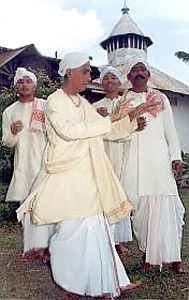 Oja-Pali is an Assamese performatory genre. In this Assamese performatory genre, the ensemble comprises a lead expert or Oja supported by a number of helpers or Pali, chief among them being the Daina-Pali. The literal meaning of this is `right-hand assistant`. There are two major forms of Oja-Pali. These can be named as Suknanni i.e. performers of Sukavi Narayana`s songs or Mare goiva or `singers at Mare Puja, the Shakta version largely centering round worship of the snake-goddess Manasa. The Biyah-gowa or `singers of Vyasa`s work` or Sabha-gowa or `singers at the sabha ceremony`, the Vaishnava version in which the themes are drawn from Vaishnava epics and Puranas. Within these two varieties, again, there are sub-varieties such as Ramayan-gowa or `Ramayana singers`, Durgabari singing Durgabar`s Ramayana, Bhaoriya or `actor-centric`, and Satriya or `monastic`.
Oja-Pali is an Assamese performatory genre. In this Assamese performatory genre, the ensemble comprises a lead expert or Oja supported by a number of helpers or Pali, chief among them being the Daina-Pali. The literal meaning of this is `right-hand assistant`. There are two major forms of Oja-Pali. These can be named as Suknanni i.e. performers of Sukavi Narayana`s songs or Mare goiva or `singers at Mare Puja, the Shakta version largely centering round worship of the snake-goddess Manasa. The Biyah-gowa or `singers of Vyasa`s work` or Sabha-gowa or `singers at the sabha ceremony`, the Vaishnava version in which the themes are drawn from Vaishnava epics and Puranas. Within these two varieties, again, there are sub-varieties such as Ramayan-gowa or `Ramayana singers`, Durgabari singing Durgabar`s Ramayana, Bhaoriya or `actor-centric`, and Satriya or `monastic`.
An Oja-Pali performance combines narrative singing and dancing interspersed with dramatic dialogue and action. Impromptu play-acting is more or less integral to the form. The songs are set to various ragas basic to the Oja-Pali system and talas peculiar to it. There are no accompanying instruments except the cymbals. Thus, apart from being an accomplished singer, the Oja must be adept at dancing. The system has its own elaborate codes of mudras, gaits, and glances. As the singing of the various narrative and other pieces proceeds, the Oja constantly keeps the rhythm with his feet and simultaneously illustrates the contents with appropriate bodily gestures and facial expressions. Frequent breaks are taken to introduce explanatory dialogues, very often in a lighter and extemporaneous vein, in which the Oja and Daina-Pali dominate. The proportion of purely theatric component varies from style to style, being highest in the Bhaoriya and Mare-gowa forms of Kamrup and Goalpara regions respectively.




